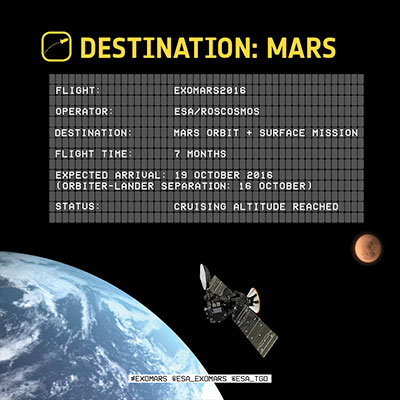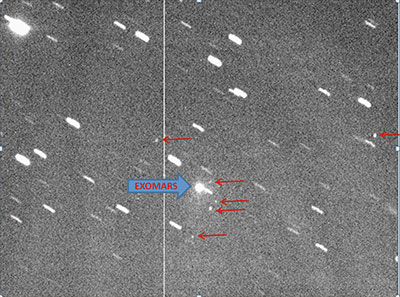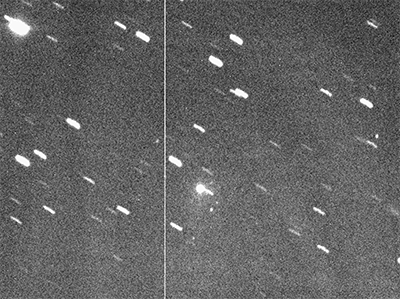 Space News space history and artifacts articles Messages space history discussion forums Sightings worldwide astronaut appearances Resources selected space history documents |
If you have previously registered, but forgotten your password, click here.
| ||||||||
| Robert Pearlman | ESA update: Signal from ExoMars TGO confirmed! We have a mission to Mars!  | |||||||
| Robert Pearlman | ESA photo release For asteroid hunters, ExoMars offers a perfect target because its departure mimics, in reverse, the approach of a small near-Earth object, or NEO. These include rocky asteroids formed between the orbits of Mars and Jupiter which head towards Earth every so often.  | |||||||
| SkyMan1958 | Just for interest's sake, does anyone know approximately how far away from the Earth the ExoMars was in these images? | |||||||
| Robert Pearlman | I can't find a distance cited, but there is reference to the images being captured near the time that the Earth escape burn was performed. Based on that, ESA earlier stated that ExoMars would be about 3,000 miles (4,900 km) above the Earth when the Briz-M performed that final burn. | |||||||
| Robert Pearlman | The "six fainter spots" described as "elements of Proton's discarded upper stage" appears to indicate something went wrong with the Briz-M upper stage after ExoMars separated, Anatoly Zak reports for Popular Mechanics. ...Briz-M was supposed to separate cleanly in one large piece without producing any additional fragments. Secondly, and more importantly, after the separation the space tug was programmed to fire twice to propel itself to a safe disposal orbit as far away from its former cargo as possible. The resulting "graveyard" trajectory would ensure that the "blind and deaf" space tug, now drifting through interplanetary space, would not come anywhere near Mars, where it could contaminate the planet's pristine environment with Earth's bugs. (Unlike Mars landers, rocket stages are not sterilized in accordance with strict international standards.) | |||||||
| Robert Pearlman | The head of Russia's Roscosmos space agency on March 31 rebutted claims from amateur satellite watchers that the Proton rocket's upper stage came apart in orbit March 14 shortly after releasing the Euro-Russian ExoMars satellite, reports SpaceNews. Briefing reporters in Moscow, Igor A. Komarov reiterated statements made by Proton prime contractor Khrunichev Space Center of Moscow, saying the Breeze-M upper stage separated ExoMars without incident and then proceeded with the standard passivation and collision-avoidance maneuvers. | |||||||
| Robert Pearlman | The Schiaparelli lander separated from the Trace Gas Orbiter on Sunday (Oct. 16) in preparation for its landing on Wednesday (Oct. 19). The Schiaparelli module was released from the Trace Gas Orbiter (TGO) at 14:42 GMT (16:42 CEST; 10:42 a.m. EDT) as planned. | |||||||
| Robert Pearlman | European Space Agency update: The ExoMars/TGO orbiter is in great shape and ready to swing into orbit around Mars, while the Schiaparelli lander is programmed to wake up at about 15:37 CEST [9:37 a.m. EDT] for its landing demonstration mission. | |||||||
| Robert Pearlman | Whether intact or in pieces, Schiaparelli is now on Mars. Just waiting for a signal (or lack thereof) to find out its fate... | |||||||
| Robert Pearlman | From the European Space Agency on Twitter: Schiaparelli recording from Mars Express is inconclusive — not clear yet what the status of the lander is.In better news, the Trace Gas Orbiter appears to have made it into Mars' orbit. Acquisition of orbiter signal! ESOC hears Trace Gas Orbiter's signal loud and clear after it emerges from behind Mars. | |||||||
| Robert Pearlman | From the Trace Gas Orbiter (@ESA_TGO) on Twitter: YES! CONFIRMED! I'm in Mars orbit!From ESA Operations regarding Schiaparelli: Experts will work through the night to assess the @ESA_EDM situation - next news will be tomorrow morning at 10:00 CEST. | |||||||
| Paul78zephyr | Europe's Schiaparelli lander not only slammed into Mars at "a considerable speed," but it may have exploded on impact, a new photo from a U.S. orbiter has revealed.This must be a big disappointment for ESA. I cannot believe MRO found the EDM that fast. I'm looking forward to seeing the HiRISE pics. Robert can you comment on what ESA spent on the EDM and compare that to what NASA spent on similar Mars missions? | |||||||
| Robert Pearlman | ESA, to my knowledge, has not publicly broken out the individual cost of Schiaparelli, or, for that matter, the ExoMars 2016 mission (including Trace Gas Orbiter). It states on its website: The European cost of the ExoMars programme is €1.3 billion (under economic conditions of 2008), assuming launches in 2016 and 2020.That means ESA's cost is about $1.5 billion. (The amount being spent on ExoMars by Roscosmos, NASA and others is not included. I haven't seen a total budget for the program.) Keep in mind that Schiaparelli wasn't designed to be a full-fledged Mars landing mission. It was a demonstrator with a very basic science package. NASA never launched a comparable spacecraft — it went full bore with each of its landers and rovers. But for comparison's sake, NASA's 2008 Phoenix lander cost the U.S. $386 million, including the launch. | |||||||
| Paul78zephyr | Robert, thank you very much for that information and analysis. It is appreciated. | |||||||
| Blackarrow | Robert's mention of NASA's Phoenix lander reminds us that that success ultimately grew from the failure of Mars Polar Lander in 1999. I seem to recall that MPL's failure was due to a faulty rocket-engine design. It's too early to draw any conclusions from the crash of Schiaparelli, but it looks like everything worked up to the end of the parachute phase. The crash site is comfortably within the landing ellipse, so guidance wasn't a problem. Faulty rocket system? Faulty software switching the rockets off too soon? We'll see. I'm tempted to say that the operation was nearly a success, but the patient died. | |||||||
| Robert Pearlman | Early indications, according to ESOC director of operations Rolf Densing (via Susanne Auer): Cause of Schiaparelli crash: Radar-altimeter software timed out, leading on board computer to think it was on ground and shut-off retro thrusters. | |||||||
| Brian Bayley | From ESA's release: It is possible the hydrazine propellant tanks in the module exploded preferentially in one direction upon impact, throwing debris from the planet's surface in the direction of the blast, but more analysis is needed to explore this idea further.How can anything "explode" in an atmosphere of carbon dioxide, a gas which doesn't support combustion? Please excuse my ignorance if the answer is obvious. | |||||||
| SpaceAholic | From ESA: The enigma of methane on Mars Methane (CH4) is an organic molecule present in gaseous form in the Earth's atmosphere. More than 90% of methane on our home planet is produced by living organisms. The recent detection of plumes of methane in the northern hemisphere of Mars is of great interest because of its potential biological origin, though other explanations may also be possible. | |||||||
| Ross | quote:The word explosion only refers to a sudden outburst of a fluid, usually a gas. It can be caused by a number of events, only one of which requires oxygen. In the case in point the hydrazine is under pressure. If the vessel is ruptured or the welds become weak, etc., there can be a sudden release of pressure often causing a larger rupture. This is often referred to as an explosion. | |||||||
| SpaceAholic | After 1,000 orbits around Mars, the Trace Gas Orbiter (TGO) has reached its ideal position to study the planet's atmosphere and has made its first scientific observations, Nature reports. It is poised to solve one of the most controversial mysteries in Martian science: why methane, a possible signature of life, is being released on the red planet. | |||||||

